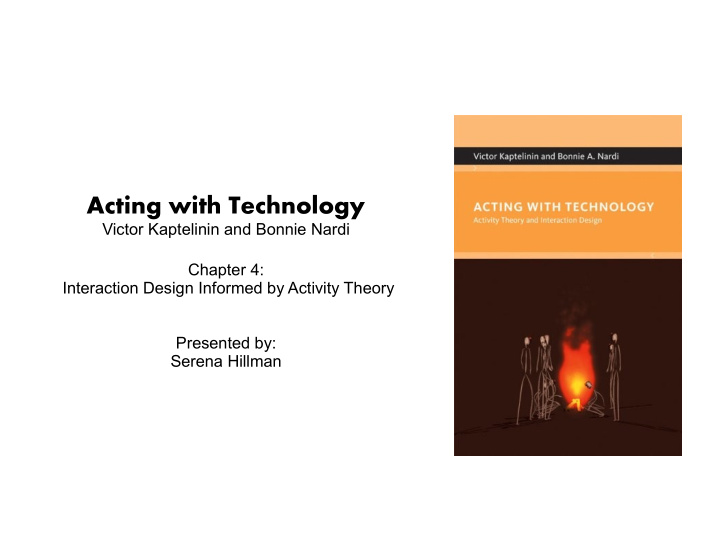



Acting with Technology Victor Kaptelinin and Bonnie Nardi Chapter 4: Interaction Design Informed by Activity Theory Presented by: Serena Hillman
Discussion Topics 1. History 2. Ways activity theory has helped re-frame key HCI concepts ● Transparency ● Affordance ● Direct Manipulation 3. Norman ABC/Opendoc 4. bodyWise Personal Trainer 5. Instrumental Genesis
HCI + Activity Theory History Russia 1920s ● In 1990s became known in HCI, ● Information systems etc. Mostly theoretical as a tool to analyze ● design of concrete technologies East-West HCI conferences solidified ● its arrival Most HCI relied on looking at existing ● systems retrospectively to illustrate conceptual claim
HCI + Activity Theory History Question: Do you think activity theory could have been introduced earlier in HCI?
Rethinking Traditional HCI Concepts 1. Transparency Traditionally: Represents User Interface ● Quality Meaning is described by ● what it is not Allows user to do work while ● the artifact remains “transparent” (metaphorically)
Rethinking Traditional HCI Concepts 1. Transparency With Activity Theory: Good Design != Transparency Individuals are aware of their actions ● Transparency can not be built into the system or a fixed property ● Transparency can be accomplished via skill automatization ● Designers can only facilitate skill automatization ● ex. by mapping user interface components ●
Rethinking Traditional HCI Concepts 2. Direct Manipulation Traditionally: Introduced by Shneiderman 1980s ● Attempt to describe features of a new type of user interface emerging ● Formulate criteria for designing successful interfaces of a new type ● WIMP – UI ● Act with objects in the ● physical world
Rethinking Traditional HCI Concepts 2. Direct Manipulation With Activity Theory: Users seldom operate on their objects of interest, such as documents directly ● In physical and virtual worlds users employ instruments which in turn produces ● desired effect UI design should differentiate between domain objects (potential objects of ● interest to the user) and interaction instruments (UI components which transform user actions into commands for the domain objects) Beadouin-Lafon – aim of design should be to provide an optimal integration of ● domain objects and interaction instruments, rather than make interaction as direct as possible
Rethinking Traditional HCI Concepts 2. Direct Manipulation Question: Can you think of an example of good UI based on optimal integration of domain objects and interaction instruments?
Rethinking Traditional HCI Concepts 3. Affordance Traditionally: Concept originally ● introduced by Gibson within the framework of his ecological approach to visual perception Introduced in HCI by ● Norman – Good UI design will implement affordance that provides strong visual clues to the operation of things
Rethinking Traditional HCI Concepts 3. Affordance Question: How were the traditional concepts of affordance re-evaluated with the introduction of activity theory?
Norman and ABC Norman proposed a new approach – ABC Activity based computing ● Concept was to make it possible to have all material needed for an activity to be ● ready at hand and available with little or no mental over head Turned Activity theory into a four-level hierarchy: ● Activities, tasks, actions, operations – ABC was closely linked to OpenDoc ● http://www.youtube.com/watch?v=oFJdjk2rq4E Question: Why do you think ABC failed and OpenDoc was abandoned?
The bodyWise Personal Trainer First technology to be designed using activity theory that was actually implemented ● as a concrete industrial prototype Motivation to workout includes the desire to appear physically and athletically ● competent – resulted in fear of trying new exercise Activity theory had a unique impact on the device's design not attributed to industrial ● design or HCI methods “Wristwatch like” device not only provided heart-rate and stopwatch features but ● workout regime instructions Question: Can you think of another application or physical prototype that employees activity theory?
Instrumental Genesis Proposed by Pierre Rabardel (2000) ● Hybrid of Activity Theory and French Ergonomics ● Focuses on the integration of artifacts into the structure of human activities ● Stated that appropriation of humans and artifacts does not happen all at once ● Instrumentalization: users make changes to to artifacts and adjust them to their ● specific needs Questions: How does design by users relate to convention design that is designed by ● designers? Is web 2.0 “design-in-use” or “design-for-use”? ●
Recommend
More recommend